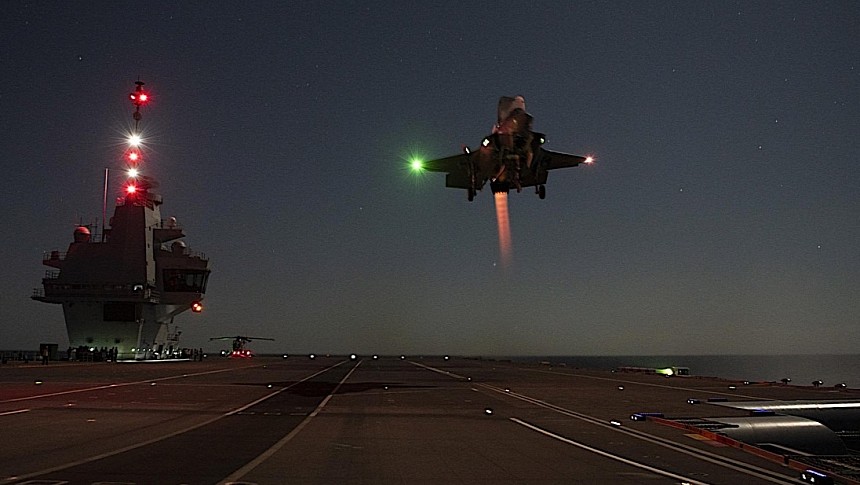They call it the HMS Prince of Wales (R09), and they describe it as the "most powerful surface warships ever constructed in the UK." And judging by its capabilities, that's not an untrue statement.
The aircraft carrier is the second of the Queen Elizabeth-class ships to be launched, after the HMS Queen Elizabeth. It was launched in 2019, packing a displacement of 65,000 tons, and a length of 284 meters (932 feet).
The ship is capable of carrying in missions up to 1,600 people, no less than 36 F-35 fighter planes, and four Merlin helicopters. As a twist, the ship comes with a very peculiar thing about it: it does not have catapults and arrestor wires, normal gear on ship meant to serve as a base of operation for fighter aircraft.
You see, the R09 was imagined as a platform for short takeoff vertical landing aircraft. A thing the F-35 Lightning II, in one of its variants, is very good at. And the machine once again proved its capabilities when it performed a kind of landing that until now was new to the British ship.
At the end of October, a pilot with the U.S. Marine Corps landed an F-35B on the deck of the carrier using a technique called night shipborne rolling vertical landing (SRVL). The milestone was reached in the waters of the Atlantic Ocean, off the coast of the United States, at the hands of Marine Maj. Paul Gucwa.
The F-35B was the first of the Lightning planes to be introduced. It came about in 2015 as a tool for the U.S. Marine Corps, and is the only one of three variants capable of performing vertical take-off and landing missions.
The SRVL landing technique used for the first time on this particular British carrier requires the aircraft to use both the lift provided by the wings and the thrust from the engines to perform a safe descent and ultimate touchdown.
It's a bit trickier than standard methods, but the advantage of such a technique is that it allows a fighter plane to hit the deck in a safe manner even if it carries additional weight, meaning, for instance, more fuel and weaponry than normal.
The SRVL method is currently in testing stages, and is only performed on the two Queen Elizabeth-class aircraft carriers. For the Prince of Wales, the landing was part of the ship's developmental test phase 3.
The SRVL was not the only procedure put through its paces as the carrier was involved in the so-called WESTLANT 23 series of trials. F-35s also performed landings in various wind over deck, deck motion, and landing speed conditions. All these procedures seem to have worked perfectly for the carrier during the 11 weeks of trials.
The ship is capable of carrying in missions up to 1,600 people, no less than 36 F-35 fighter planes, and four Merlin helicopters. As a twist, the ship comes with a very peculiar thing about it: it does not have catapults and arrestor wires, normal gear on ship meant to serve as a base of operation for fighter aircraft.
You see, the R09 was imagined as a platform for short takeoff vertical landing aircraft. A thing the F-35 Lightning II, in one of its variants, is very good at. And the machine once again proved its capabilities when it performed a kind of landing that until now was new to the British ship.
At the end of October, a pilot with the U.S. Marine Corps landed an F-35B on the deck of the carrier using a technique called night shipborne rolling vertical landing (SRVL). The milestone was reached in the waters of the Atlantic Ocean, off the coast of the United States, at the hands of Marine Maj. Paul Gucwa.
The F-35B was the first of the Lightning planes to be introduced. It came about in 2015 as a tool for the U.S. Marine Corps, and is the only one of three variants capable of performing vertical take-off and landing missions.
The SRVL landing technique used for the first time on this particular British carrier requires the aircraft to use both the lift provided by the wings and the thrust from the engines to perform a safe descent and ultimate touchdown.
It's a bit trickier than standard methods, but the advantage of such a technique is that it allows a fighter plane to hit the deck in a safe manner even if it carries additional weight, meaning, for instance, more fuel and weaponry than normal.
The SRVL method is currently in testing stages, and is only performed on the two Queen Elizabeth-class aircraft carriers. For the Prince of Wales, the landing was part of the ship's developmental test phase 3.
The SRVL was not the only procedure put through its paces as the carrier was involved in the so-called WESTLANT 23 series of trials. F-35s also performed landings in various wind over deck, deck motion, and landing speed conditions. All these procedures seem to have worked perfectly for the carrier during the 11 weeks of trials.






